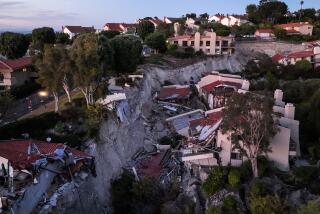‘Sandslides’ May Have Killed Dinosaurs in Gobi Desert
- Share via
NEW YORK — Dinosaurs and other creatures discovered in Mongolia’s Gobi Desert may have been killed by landslides of sand that preserved them for modern-day fossil hunters, a new analysis suggests.
In the past, some scientists have speculated that massive sandstorms killed and covered the creatures. That’s because the remarkable preservation of the fossils indicates that the beasts were killed and quickly buried before scavengers or erosion could harm their remains.
The study, which also revealed the first dinosaur footprints found in the Gobi, is presented by David Loope of the University of Nebraska at Lincoln, Lowell Dingus of the American Museum of Natural History in New York and Carl C. Swisher III of the Berkeley Geochronology Center in Berkeley. It appears in the January issue of the journal Geology.
In studying the geology of the Gobi’s Ukhaa Tolgod site, they concluded that the fossil-bearing rock was not formed by wind-blown sand. They also noted that a prior study found no accounts of smothering of animals among descriptions of desert sandstorms.
Instead, they suggested, the fossils-to-be in the Gobi may have been trapped when sparsely vegetated dunes got wet and collapsed. That could have buried fresh skeletons and maybe live animals, they concluded.
They also found depressions in sandstone layers that appear to be footprints of big dinosaurs, given the fossils found in the area. They couldn’t definitely identify which animals left them.
More to Read
Sign up for Essential California
The most important California stories and recommendations in your inbox every morning.
You may occasionally receive promotional content from the Los Angeles Times.













